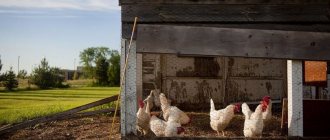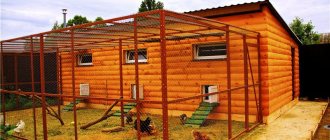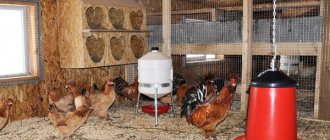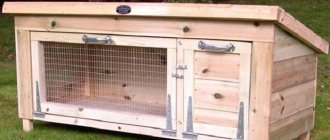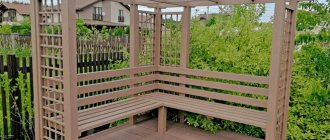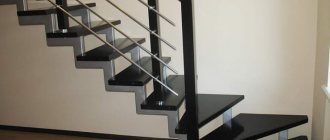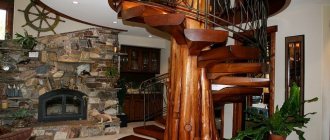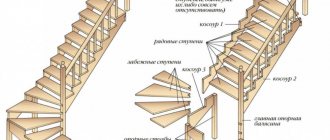A portable chicken coop is a device that is used most often on subsidiary farms. Thus, its main purpose is to make life easier for the farmer and improve the life of chickens, since some are deprived of the need to provide 100% of the chickens’ diet in the summer, since due to the movement of the chicken coop, pasture is constantly updated, while others get the opportunity to breathe fresh air outside and eat fresh grass. You can either buy a portable chicken coop in specialized stores or make it yourself. Let's look at what types of these buildings are used by farmers today and how to make them.
A portable chicken coop can be either absolutely simple or grandiose.
Designs of mobile chicken coops
The traditional design of a mobile chicken coop, which a skilled craftsman can make in about five minutes, is prepared from simple materials:
- slats;
- boards;
- mesh, either metal or plastic.
Portable chicken coop design
As a rule, from the materials listed above, either an elongated pyramid or a cube is knocked together, the edges of which are slats, the walls are mesh, and the space that should act as a ceiling is covered with boards. Making a solid ceiling is necessary to protect birds from the negative effects of weather conditions, for example:
- rain;
- scorching sun.
The structure we described is very, very simple; however, such poultry houses are not capable of replacing a permanent building for chickens, since if the birds have no other place of residence, it is necessary:
- equip a portable chicken coop with a place for laying eggs;
- make a larger chicken coop;
- arrange a separate house for chickens inside the portable structure, inside which they will hide from the wind and cold.
Drawing of a traditional chicken coop with a compartment for young animals
There are three distinctive parameters by which one can distinguish the existing chicken coop designs manufactured by farmers today. Let's look at them in the table below.
Table 1. Main characteristics of mobile chicken coops
| Parameter | Description |
| Moving method | So, as for the methods of moving such chicken coops, today there are known designs that:
|
| Magnitude | The size of the chicken coop will depend on several factors, for example:
|
| Format | The format of the chicken coop will directly depend on the purpose and your imagination. So, if a portable chicken coop should become a serious refuge for birds until they move into a permanent building in late autumn, then it is unlikely to be represented by a simple box of slats and mesh, most likely it will be a structure of several segments, for example:
|
Chicken coop with pen and house
Self-construction technology
Scheme for constructing a portable chicken coop independently:
- First they make the frame. They use two triangular frames, the material is timber. The frames are fastened with boards, to which handles for carrying are screwed.
- Then, the walls of the lower side part are made from slats. A mesh is stretched between each wall. Use a chain link with small mesh. The ceiling between the levels is made of plywood with a hole for birds. A ladder is inserted into this hole.
- Decide which wall will be removable. This will be the entrance to the room. The second wall is being built from clapboard.
- The second tier is divided into two zones. The first zone will contain perches, the second will house a recreation area.
- Make sure you have quality shelter. It is made from pieces of plywood held together with loops. In hot weather the roof can be removed. One of the parts of the roof should always be removed, this will ensure ease of cleaning in the poultry house.
- At the end of the work, treat all parts of the house with protective agents or varnish.
These are the main stages of building a chicken coop, the remaining features are additional: light, heating, ventilation.
Lighting and ventilation
To protect livestock from the harmful effects of drafts, precipitation and various wild animals, it is necessary to ensure the construction of a ventilation system that will not have large gaps.
Fresh air is necessary for the life of birds; it will protect the chicken coop from rapid rotting and dampness.
Make a small window - sunlight will come through it, which is very useful, and it will also become an additional source of natural heat in the summer.
Positive and negative aspects of using portable chicken coops
Before you buy or make a mobile poultry house yourself, you need to familiarize yourself with all its positive and negative sides, which, as you know, each phenomenon has. In addition, it will be very important to understand in advance which form of the product is right for you, since portable chicken coops that are thoughtlessly made do not always simply fit into the intended place on the site, and the structure has to be disassembled and literally redone.
Portable chicken coop with large pen
So, let's look at the positive and negative aspects of this structure.
1. Positive aspects:
- this structure can be moved at any time, for whatever reason there is a need to change its location;
- birds that feed and walk in conditions close to natural conditions are, as a rule, healthier;
- the meat of birds walking in this way is saturated with vitamins and oxygen, and therefore it is more tender and tasty;
- there is no need to regularly clean the poultry house, since a week after standing at one point on the site (during this time bacteria accumulate), you just need to move the house to another site, and at the previous parking spot, bacteria and all harmful substances will be eliminated by themselves;
You can move the chicken coop to a new location at any time.
- the birds in the chicken coop eat the most healthy foods, such as green grass, as well as protein food in the form of worms, beetles, and other insects;
- creating a poultry house yourself is a task that even an inexperienced farmer can cope with;
- if you have enough construction skills, you can build a chicken coop as functional and beautiful as you like, equipping it with various additional rooms and decorative, as well as functional, elements;
- a chicken coop can, if desired, become part of the overall design of a house or site, even if you just slightly complete or alter the purchased structure;
- products that are portable are much easier to clean than those that are stationary, especially considering that you don’t need to clean the surface of the ground at all;
A portable chicken coop is easier to clean
- provided that you have a pond or stream on your site, you can place the chickens near it, or even one part of it, thus solving the problem of watering the chickens and adding coolness to the birds on hot days;
- chicken coops that you move around the site are not expensive, especially if you make them yourself, since the materials used in construction are extremely simple and inexpensive.
2. Negative aspects:
- the impossibility of providing chickens with decent shelter even for the winter, so if you make a sufficiently warm structure, it will be very difficult to move it;
- inability to accommodate a large number of chickens, in other words, this option is not suitable for running a large farm.
A portable chicken coop cannot accommodate a large number of birds.
As you can see, the pros of this chicken coop significantly outweigh the cons, but you can’t isolate yourself from the latter either, since they are represented by two quite important nuances that should be taken into account by both beginning and experienced poultry farmers.
pros
Each chicken coop, whether made by hand or purchased in stores, has a number of pros and cons. Main advantages:
- The design of the mobile chicken coop can be quickly moved to any place in the garden. It follows from this that chickens will always be able to eat animal feed and green herbs - this is an important point in their development.
- Possibility of changing the design of the building. It will be not only functional, but also decorative and will decorate the site.
- The design is easy to clean; you can place it in a convenient place where you can carry out all hygiene procedures.
- A portable chicken coop can be either summer or winter. During the cold season, the structure can be placed close to the house to make it easier to care for.
- The structure is inexpensive and can be easily erected with one’s own hands, with minimal construction skills.
Instructions for creating a chicken coop
The technology for creating a chicken coop of the variety we are interested in will vary slightly depending on what form of this structure you plan to build. However, the general principles will remain the same. Let's look at an example of how to build a good portable chicken coop.
Step No. 1 - assembling the frame
First we will need to assemble the base of the future chicken coop. For this we need wooden slats made of timber:
- in the amount of 4 pieces;
- 2, having a length of about a meter;
- 2, having a length of 2 meters
- metal corners;
- self-tapping screws
Timber is the material we chose for construction
Prices for various types of timber
timber
Now that we have everything we need, we just need to sequentially connect the beams to each other using metal corners and self-tapping screws, which ultimately form a rectangle of the correct shape. This will be our foundation.
Please note: you can change the size of the base at your own will, but it is better not to make it smaller than in our example, but, on the contrary, change it upward, giving the chickens space to live.
This is what our foundation should look like, in the image of which we need to assemble the roofs and the wall
Step No. 2 - assembling the roof and walls
As they say, everything ingenious is simple, therefore, in this example we are considering a chicken coop that can be completed even by a person who does not have construction skills. That is why our next step will be as simple as the first: we need to assemble exactly the same frames for the walls and roof of the chicken coop, taking into account that:
- the frame for the roof will completely repeat the frame for the floor;
- the parameters of the long side frames will not change, so their length will be 2 meters and the height will remain one meter;
- the side frames that will be “back” and “front” can be made 1 meter by 1 meter.
Using the same screws and corners for fastening, fasten the beams together and get four parts for the future chicken coop
Step No. 3 - making a frame for the door
So that we can open our chicken coop and catch the chickens, we should make a door in one of the walls. To do this, already at this stage we must do the following:
- nail a vertical strip to the middle of one of the blanks so that it reaches tightly from one edge of the frame to the other;
- Having measured the resulting half of the space, make another square from thinner slats by analogy with how we did it for large parts.
The square that will then become the door should fit snugly into the hole represented by half of the side wall, as the chickens should not be given a chance to leave the coop without your knowledge. A little later, this square, using door hinges, will need to be fitted to the beam protruding in the middle of the blank for the wall. On the other hand, at the desired level, attach a hook or latch to the rail.
The door to a portable chicken coop can be made either from a frame and mesh, or entirely from wood
Step No. 4 – attach the mesh
Now that all the necessary preparations have been completed, you should assemble the portable chicken coop. To do this, we will need all the same corners, self-cuts or any other fastening accessories.
So, earlier you selected the grid. It could have been a plastic mesh, like the ones they put on windows in residential areas to keep out mosquitoes, or it could have been a small mesh metal mesh. It doesn’t matter what you choose, although it is advisable:
- so that chickens cannot stick their head or other part of their body through the mesh;
- so that the net protects the chickens from flying insects;
- so that the mesh is not too dense, as this impairs air circulation.
The mesh can be attached to the frame in any way you like
Now that you have decided which mesh is right for you, you need to attach it to each of the frames we mentioned earlier, namely:
- on one of the long side walls;
- on the back and front walls;
- on the chicken coop door;
- on the second part of the chicken coop wall divided in two.
Our floor frame remains without any nets, since it would be inconvenient for chickens to walk on them, in addition, this would complicate the process of moving the chicken coop around the territory. As for the roof, we will complete it differently.
If desired, you can choose a chain-link mesh or a solid metal mesh for the chicken coop
Prices for mesh netting
Rabitz
Step #5 - assembling our chicken coop
Now, using the stacks, roof and base we made, we connect the parts to each other. Our roof is still unfinished, but that’s okay, we’ll finish it in the next step. Carefully attach the building parts to each other, using the same:
- corners;
- self-tapping screws;
- nails;
- bolts and other fastening devices that you prefer.
Once all the parts are attached, there are only a couple of steps left that we will need to complete.
Drawing of a chicken coop with a house inside
Step No. 6 - making the roof
Making a roof for a chicken coop yourself will not be difficult, since, as we remember, ours is portable. Turn the chicken coop towards you so that it stands under you on the side on which the roof should be located. Now take pre-prepared sheets of thin plywood and nail them one by one to the top of the cage, thus:
- so that there are no gaps between the frame ribs and the plywood;
- to prevent nails or other fastening devices from coming out the other side of the slats, thereby leaving the chickens open to injury.
The roof is best made from sheets of plywood, no matter what shape of the chicken coop you choose
Now that you have secured the roof, our cage is almost ready.
Step #7 – finishing touches
Hurray, we only have a few things left to do before we can use our chicken coop for its intended purpose.
1. First of all, it is necessary to equip a lock that will prevent escape from the chicken coop. Its role may be:
- latch;
- hook;
- hinges for a lock, etc.
The easiest way is to buy a hook and screw it on, even if you didn’t have an eyelet in the kit into which the hook should be inserted, you can make it yourself by coming up with a replacement, for example, from a bent nail.
Make sure that the chicken coop is closed with a hook or other lock.
2. The second thing you need to do is add handles by which you will carry the chicken coop. It is best to make them like the handles of a wheelbarrow, on both sides of the building, so that you can move it with a family member.
Step No. 8 - processing the timber
You can use our instructions in another way, doing the same thing, but not from timber, but from a metal profile. In this case, you will not have to process the frame of the resulting chicken coop. If you still decide to choose the classic manufacturing method, you will have to treat the pieces of wood with special compounds that will protect them from:
- moisture;
- temperature changes;
- insects
If you used wood for your work, saturate it with antiseptics and insect repellents
These compositions are not safe for birds, therefore, after painting the birds cannot be placed inside for some time, however, a little later it will still be possible to do this, as soon as all the volatile substances have evaporated and the compositions have dried.
Now we have done everything that was required, and our chicken coop is ready! At this stage, the creation of the design comes to its logical end. If you planned to build this structure only for the purpose of summer chicken walking, then this will be enough. In the case when you additionally equip the premises inside the chicken coop in which the chickens will sleep or lay eggs, you will also need to take care of the following two nuances:
- ventilation;
- lighting
The finished chicken coop can be decorated with flowers or simply painted in appropriate colors
We'll see what exactly needs to be done in the next section.
Varieties
What is the difference
The portable chicken coop is presented in several variations, differing in the following characteristics:
- method of transfer from one place to another;
- size: from several to 20 chickens or more;
- design features.
There are a number of other differences. For example, is the building equipped with wheels, which makes it easier to move even if it is large? If they are not there, then a chicken coop with a light weight will be convenient. The size is selected depending on the number of chickens.
Let's take a closer look at the possible options.
Portable
An example is a lightweight design for 10 adult laying hens. This is the maximum number of individuals. The compact chicken coop allows you to change the location, providing your pets with fresh grass.
At the same time, the walk becomes spacious. And a person enters the room at full height, using an additional door at the back.
A small window is constructed under the roof to allow air to circulate. And on the sides of the “interior” there are nests for eggs.
Common features are a mandatory room for laying hens, a perch and an aviary for walking. A popular form is a box. A couple of boards are nailed from below. They serve as handles for moving.
Having built a similar chicken coop for 10 chickens with their own hands at their dacha, craftsmen can decorate it.
Arched
This type of poultry house has a semicircular shape. Thanks to it, the weight of the structure is reduced. This increases mobility. This is a popular variety.
Chicken coop-wheelbarrow
It is difficult to move the mini-chicken coop on your own once every 2 days to fresh grass. A mobile structure on wheels will help out.
An example of such a model is a wheelbarrow. The model consists of a mesh box on small wheels. Thanks to this, the structure can be moved by one poultry farmer.
The design does not include a part for chickens to roost overnight. Because it is used in conjunction with a stationary chicken coop.
On casters or wheels
This design is easy to implement. It can be transported around the site manually. Sometimes without the help of a second person, even if it is quite large.
This house is similar to a portable chicken coop. The only difference is the wheels.
A structure on casters cannot be used as a trailer. And attach it to a car for transporting chickens. It moves only on a surface such as concrete or asphalt within the dacha area.
Chicken coop trailer
A large mobile poultry house with a walk and a house for the night. Used for transporting chickens over distances. It is attached to the vehicle as a trailer. It is also used on the site.
How to equip lighting and ventilation in a chicken coop
Ventilation
In order to maintain a digestible temperature inside the chicken coop, it is necessary to equip a ventilation system. Otherwise, your livestock will face various diseases, since ventilation is one of the hygiene points for chickens. In addition, another benefit that ventilation brings is getting rid of the unpleasant smell of chicken feces.
If your chicken coop, as in the example above, is ventilated from all sides, then you don’t need to come up with additional ventilation, because you already have it.
It is necessary to ventilate the closed part of the chicken coop, otherwise the chickens will start to get sick.
At the same time, chicken houses inside a portable structure must be equipped with lockable ones:
- pipes;
- windows.
These parts need to be made small so that in colder times all the heat does not escape through them. Take care of them to improve the health of your feathered charges.
Lighting
It is also very important to remember that the light in the chicken coop determines how well the chickens:
- will quickly add muscle mass;
- will often rush;
- healthy ones will produce eggs, and how thick will the shells of these eggs be;
- will the young animals be viable;
- will the development of day-old chicks proceed correctly, etc.
The lack of sufficient lighting negatively affects the condition of the birds, therefore, you need to consider additional artificial light for a portable chicken coop.
The inside of this house, one way or another, needs to be equipped with a light device, since without it it will not be possible to create the healthiest regime for the life of chickens
In principle, since the size of this structure will be limited in any case, you don’t have to worry too much and place your main hopes on natural light, which will penetrate into the ventilated part through the walls, and into the house through the windows. To avoid any problems, place chicken feeders outside.
To illuminate the inside of the closed part of the chicken coop in the evening, it is best to provide lighting inside in the form of a portable LED lamp. This lighting device runs on a battery and holds a charge for a long time, and it is sold everywhere. The fact is that your chicken coop will move around the territory, and if you do not want to constantly carry cords behind it to connect the lighting, and always keep in mind that the chicken house is energized, a lamp with a battery is your option. Portable light bulbs can be placed in a room, not just one, but several.
A portable lighting device is the best way out of the situation
Prices for a portable rechargeable lamp
Portable battery lamp
Ready-made poultry houses
Most farmers choose ready-made structures. They can be made to order or selected from among completed products. There are various configurations, sizes, designs.
Models of houses that are designed to accommodate ten chickens will be very small and compact.
Mobile bird houses for twenty birds are a full-fledged building in which all the requirements for breeding chickens will be met.
The finished products have a well-developed ventilation system, heating from the ceiling, and temperature control. Some buildings have perches, feeders, drinking bowls, nests - all the necessary equipment for the immediate start and settlement of individuals. There are buildings with and without walking areas.
Some companies offer services for the production of chicken coops according to your personal sketches, taking into account all the requirements and wishes.
Interesting tips
We invite you to consider a list of life hacks from experienced farmers that will help you arrange your chicken coop in the best possible way.
1. Spring weather factors. External factors of nature can greatly harm the structure that we are putting together. We are talking about such natural phenomena as:
- rain;
- strong wind.
Parts of this structure can gradually become detached under the influence of the elements, breaking up into segments. To prevent this from happening, you can:
- make a chicken coop from a metal profile, the elements of which are welded to each other;
- secure the chicken coop parts with high-quality fittings;
- prepare a separate shed for the portable chicken coop;
- figure out how to secure the chicken coop to the ground.
Provided that the wind has picked up, the chicken coop can be secured in a similar way to setting up a tent - with cables with pegs at the ends driven into the ground
2. Draft inside the chicken coop. The second point to consider is draft prevention. To prevent drafts from moving around the house inside the portable chicken coop, it is necessary to fasten the parts to each other in such a way that there are no gaps between them. However, it is still necessary to ventilate this room for birds, since a long-term lack of ventilation can lead to the occurrence of a huge number of avian ailments.
3. Location level. It is best to install the chicken coop directly on a hill. This way you will prevent moisture from accumulating at the base of the coop. Chickens have very delicate feet, which are seriously susceptible to various skin diseases. Additionally, if your chicken's feet are exposed to the cold, it is more likely that she will get sick after a while. Therefore, always carefully choose the next location to place your portable chicken house.
Make sure that moisture does not accumulate in the chicken coop
4. Fight against insects and parasites. It is better to decorate the windows inside the chicken house, as well as its walls, with a wall designed to protect against mosquitoes. These flying insects love to feast on chicken blood, which greatly irritates your feathered pets, worsening their health parameters, therefore, it is better to choose just such a net. Preventive treatment of the chicken coop against fleas and lice is also necessary.
Signs of skin parasites
The appearance of rats near the chicken coop becomes a big problem. Many farmers are interested in the question: how to deal with rats in a chicken coop? Read more here.
5. Seating of young animals. A standard-sized portable poultry house involves keeping up to 10 representatives of young chicken inside. After the young animals grow up, it is necessary to leave only five birds in the chicken coop, the rest should be placed in another similar chicken coop.
The chicken coop should not be overcrowded
6. Portable chicken coop for the winter. If you have equipped a chicken coop with houses or perches, and plan to keep chickens in the winter, it is not necessary to equip them with another permanent structure. Simply move your existing chicken coop into a barn or other insulated outbuilding, install light and, if possible, heating, and use the summer version of a portable chicken coop as a winter shelter.
In order to eat fresh eggs and poultry all year round, it is necessary to properly insulate the house for laying hens, providing them with a comfortable winter. Step-by-step instructions are presented in one of our articles .
7. Several tiers. It is very convenient to make a portable chicken coop in two tiers. So, small chickens will be kept on the second floor, and adults on the lower tier. As birds grow older, they can be moved from one tier to another.
Equipped portable chicken coop
8. Comfortable insulation. To insulate your multifunctional chicken coop in winter, use thermal insulation materials that will cover the walls of this room. It is best, of course, for the structure to be moved inside a barn.
Climatic conditions
When constructing a structure, it is important to take into account the climatic characteristics of the region. Strong winds and precipitation will damage the poultry house. That is why it is so important to make a structure without cracks. It is important to periodically ventilate the room.
If you place the chicken coop in an elevated place, you will be able to avoid moisture accumulation. To protect chickens from pests, windows and doors are equipped with mosquito nets.
A mobile chicken coop is a very convenient structure that is perfect for small farms. To ensure normal development of chickens, it is important to think through the design of the poultry house down to the smallest detail.
Chicken coop on wheels
A chicken coop on wheels is made in the same way as any other structure of this type. However, if you want to add wheels to the design, it is best to slightly modify the process of bringing this design to life.
Portable chicken coop on wheels
So, to begin with, it is better to draw a diagram of the future structure, which will indicate such nuances as:
- number of details;
- manufacturing materials;
- assembly stages;
- segment sizes, etc.
Without creating a drawing, it will not be possible to implement the idea one hundred percent correctly and technically, since it is very difficult to keep inside your head exactly how certain elements of the frame should be located.
You should also pay attention to the following fact: if experienced people are building your chicken coop, then they may not need a drawing, but especially for those who are not knowledgeable in these matters, it is better to think through everything on paper in advance.
A chicken coop on wheels can have any shape
The next step is to understand what material you will use to build a chicken coop with wheels. In our opinion, if you do not have the skills of a builder and welder, it is best to choose wood so that the wheels can simply be screwed to the side.
In order for the structure to move normally, it is best not to make it higher than two meters, since otherwise there will be much more fuss with the wheels.
It is also very important to initially understand in which area the closed part of the planned structure will be located, since this is where the wheels will need to be screwed on. The thing is that to move the structure, it is most logical to place them on the side that will not rise. Therefore, since the closed part is the heaviest, this must be done under it.
Drawing of the closed part of a portable chicken coop
It is best to take bars for the frame:
- quality;
- with a relatively small cross section.
It will be great if there is enough space inside the chicken coop to create walls and partitions that will not only give the structure new functionality, but also balance its parts, making transportation on wheels much more convenient.
In addition, in order for the wheels to play their role and facilitate the transportation of the structure, it is also necessary to create handles for transportation. You can do them in different ways, for example:
- nailing a board or beam on each side;
- screw real handles on the front side of the back wall to make it easier to lift the structure and lead it to its destination.
You can even make wheels for the structure yourself
As for the wheels themselves, they should not be small, since with constant movement in areas with soft turf, the wheels will dig deep into the ground.
Plus, they will also serve as an obstacle for you to move, provided that you add several heads to the chicken coop, and its weight will increase.
You may be interested in other types of chicken coops. Find out how to make them yourself, detailed drawings and instructions in our article.
Peculiarities
To raise chickens in a summer cottage, it is important to choose the right type of chicken coop and find a suitable place for it. This is very important for the successful rearing of birds, since comfort and convenience depend on the location of the poultry house.
Mobile chicken coops are used to keep a small number of birds - a maximum of 10 individuals. Externally, the design resembles a portable booth. They also make structures on durable wheels. Chickens spend the night in them, hiding from rain and wind. The booth is surrounded by a metal mesh fence. This provides walking.
The most important feature of mobile poultry houses is the ability to quickly move the building to a new location. This gives the chickens access to new grass and fresh insects. Cleaning such a structure is quite easy. If necessary, you can even move it to a pond and wash it.
Finishing the chicken coop
Remember, if you are making a chicken coop out of wood, you must paint it, after impregnating it with compounds that are designed to combat:
- with moisture penetration into the wood structure;
- with insects;
- with wood falling apart and other ailments.
After the impregnation has been carried out, you need to let the structure stand until its toxic fumes are completely evaporated. Only after this you need to start varnishing the wooden elements, and then also leave the chicken coop until completely dry.
However, after this, you can apply more paint to the structure, achieving a harmonious appearance of the building that correlates well with the overall style of your site.
Finished construction
Let's sum it up
A portable chicken coop is a device that is convenient in all respects, especially when it comes to small private households. It is used mainly in the warm season, however, it will also come in handy in winter if you place it in a heated room.
Building a portable chicken coop is an art.
